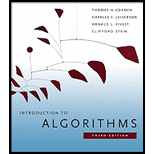
Concept explainers
(a)
To determine the asymptotic bounds for the recurrence relation using master method.
(a)
Explanation of Solution
Given Information: The recurrence relation is
Explanation:
For a divide and conquer recurrence of the form
Case 1: If
Case 2: If
Case 3: If
The values of
Therefore,
So, case 3 of the master method applies.
Hence,
(b)
To determine the asymptotic bounds for the recurrence relation using master method.
(b)
Explanation of Solution
Given Information: The recurrence relation is
Explanation:
The values of
Therefore,
So, case 3 of the master method applies.
Hence,
(c)
To determine the asymptotic bounds for the recurrence relation using master method.
(c)
Explanation of Solution
Given Information: The recurrence relation is
Explanation:
The values of
Therefore,
So, case 2 of the master method applies.
Hence,
(d)
To determine the asymptotic bounds for the recurrence relation using master method.
(d)
Explanation of Solution
Given Information: The recurrence relation is
Explanation:
The values of
Therefore,
So, case 3 of the master method applies.
Hence,
(e)
To determine the asymptotic bounds for the recurrence relation using master method.
(e)
Explanation of Solution
Given Information: The recurrence relation is
Explanation:
The values of
Therefore,
So, case 1 of the master method applies.
Hence,
(f)
To determine the asymptotic bounds for the recurrence relation using master method.
(f)
Explanation of Solution
Given Information: The recurrence relation is
Explanation:
The values of
Therefore,
So, case 2 of the master method applies.
Hence,
(g)
To determine the asymptotic bounds for the recurrence relation using master method.
(g)
Explanation of Solution
Given Information: The recurrence relation is
Explanation:
The recurrence relation is not in the form of master theorem. Therefore, it cannot be solve by master theorem.
Solve the recurrence relation
as follows:
Therefore, the asymptotic notation of the recurrence
Want to see more full solutions like this?
Chapter 4 Solutions
Introduction to Algorithms
- Please solve and answer the questions correctly please. Thank you!!arrow_forwardConsidering the TM example of binary sum ( see attached)do the step-by-step of execution for the binary numbers 1101 and 11. Feel free to use the Formal Language Editor Tool to execute it; Write it down the current state of the tape (including the head position) and indicate the current state of the TM at each step.arrow_forwardI need help on inculding additonal code where I can can do the opposite code of MatLab, where the function of t that I enter becomes the result of F(t), in other words, turning the time-domain f(t) into the frequency-domain function F(s):arrow_forward
 C++ Programming: From Problem Analysis to Program...Computer ScienceISBN:9781337102087Author:D. S. MalikPublisher:Cengage Learning
C++ Programming: From Problem Analysis to Program...Computer ScienceISBN:9781337102087Author:D. S. MalikPublisher:Cengage Learning Operations Research : Applications and AlgorithmsComputer ScienceISBN:9780534380588Author:Wayne L. WinstonPublisher:Brooks ColeProgramming Logic & Design ComprehensiveComputer ScienceISBN:9781337669405Author:FARRELLPublisher:Cengage
Operations Research : Applications and AlgorithmsComputer ScienceISBN:9780534380588Author:Wayne L. WinstonPublisher:Brooks ColeProgramming Logic & Design ComprehensiveComputer ScienceISBN:9781337669405Author:FARRELLPublisher:Cengage Systems ArchitectureComputer ScienceISBN:9781305080195Author:Stephen D. BurdPublisher:Cengage LearningCOMPREHENSIVE MICROSOFT OFFICE 365 EXCEComputer ScienceISBN:9780357392676Author:FREUND, StevenPublisher:CENGAGE L
Systems ArchitectureComputer ScienceISBN:9781305080195Author:Stephen D. BurdPublisher:Cengage LearningCOMPREHENSIVE MICROSOFT OFFICE 365 EXCEComputer ScienceISBN:9780357392676Author:FREUND, StevenPublisher:CENGAGE L C++ for Engineers and ScientistsComputer ScienceISBN:9781133187844Author:Bronson, Gary J.Publisher:Course Technology Ptr
C++ for Engineers and ScientistsComputer ScienceISBN:9781133187844Author:Bronson, Gary J.Publisher:Course Technology Ptr





